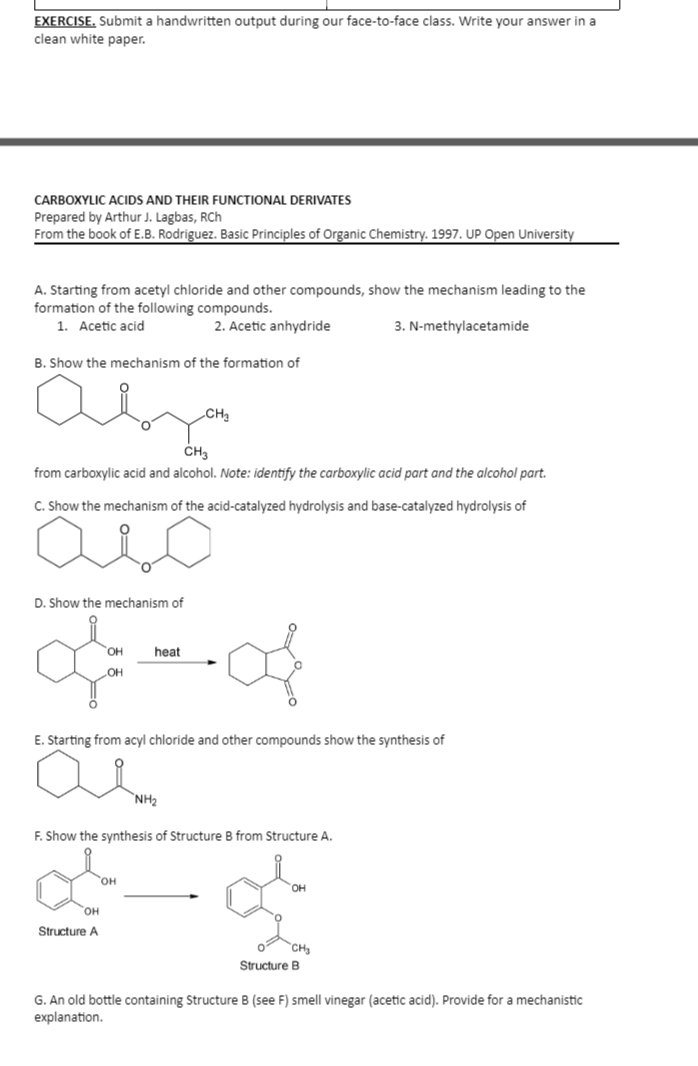A. Starting from acetyl chloride and other compounds, show the mechanism leading to the formation of the following compounds. 1. Acetic acid 2. Acetic anhydride 3. N-methylacetamide
A. Starting from acetyl chloride and other compounds, show the mechanism leading to the formation of the following compounds. 1. Acetic acid 2. Acetic anhydride 3. N-methylacetamide
Chemistry
10th Edition
ISBN:9781305957404
Author:Steven S. Zumdahl, Susan A. Zumdahl, Donald J. DeCoste
Publisher:Steven S. Zumdahl, Susan A. Zumdahl, Donald J. DeCoste
Chapter1: Chemical Foundations
Section: Chapter Questions
Problem 1RQ: Define and explain the differences between the following terms. a. law and theory b. theory and...
Related questions
Question
PLS WRITE IN BOND PAPER

Transcribed Image Text:EXERCISE. Submit a handwritten output during our face-to-face class. Write your answer in a
clean white paper.
CARBOXYLIC ACIDS AND THEIR FUNCTIONAL DERIVATES
Prepared by Arthur J. Lagbas, RCh
From the book of E.B. Rodriguez. Basic Principles of Organic Chemistry. 1997. UP Open University
A. Starting from acetyl chloride and other compounds, show the mechanism leading to the
formation of the following compounds.
1. Acetic acid
2. Acetic anhydride
3. N-methylacetamide
B. Show the mechanism of the formation of
CH3
from carboxylic acid and alcohol. Note: identify the carboxylic acid part and the alcohol part.
C. Show the mechanism of the acid-catalyzed hydrolysis and base-catalyzed hydrolysis of
aio
D. Show the mechanism of
CH₂
E. Starting from acyl chloride and other compounds show the synthesis of
as
NH₂
OH
OH
- of
heat
OH
F. Show the synthesis of Structure B from Structure A.
OH
ad
Structure A
CH₂
Structure B
G. An old bottle containing Structure B (see F) smell vinegar (acetic acid). Provide for a mechanistic
explanation.
Expert Solution
This question has been solved!
Explore an expertly crafted, step-by-step solution for a thorough understanding of key concepts.
Step by step
Solved in 3 steps with 3 images

Knowledge Booster
Learn more about
Need a deep-dive on the concept behind this application? Look no further. Learn more about this topic, chemistry and related others by exploring similar questions and additional content below.Recommended textbooks for you

Chemistry
Chemistry
ISBN:
9781305957404
Author:
Steven S. Zumdahl, Susan A. Zumdahl, Donald J. DeCoste
Publisher:
Cengage Learning

Chemistry
Chemistry
ISBN:
9781259911156
Author:
Raymond Chang Dr., Jason Overby Professor
Publisher:
McGraw-Hill Education

Principles of Instrumental Analysis
Chemistry
ISBN:
9781305577213
Author:
Douglas A. Skoog, F. James Holler, Stanley R. Crouch
Publisher:
Cengage Learning

Chemistry
Chemistry
ISBN:
9781305957404
Author:
Steven S. Zumdahl, Susan A. Zumdahl, Donald J. DeCoste
Publisher:
Cengage Learning

Chemistry
Chemistry
ISBN:
9781259911156
Author:
Raymond Chang Dr., Jason Overby Professor
Publisher:
McGraw-Hill Education

Principles of Instrumental Analysis
Chemistry
ISBN:
9781305577213
Author:
Douglas A. Skoog, F. James Holler, Stanley R. Crouch
Publisher:
Cengage Learning

Organic Chemistry
Chemistry
ISBN:
9780078021558
Author:
Janice Gorzynski Smith Dr.
Publisher:
McGraw-Hill Education

Chemistry: Principles and Reactions
Chemistry
ISBN:
9781305079373
Author:
William L. Masterton, Cecile N. Hurley
Publisher:
Cengage Learning

Elementary Principles of Chemical Processes, Bind…
Chemistry
ISBN:
9781118431221
Author:
Richard M. Felder, Ronald W. Rousseau, Lisa G. Bullard
Publisher:
WILEY